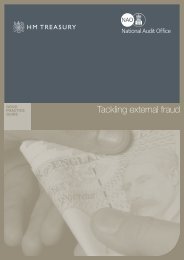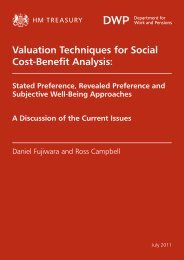4. First case study – the subdivision of the light - HM Treasury
4. First case study – the subdivision of the light - HM Treasury
4. First case study – the subdivision of the light - HM Treasury
You also want an ePaper? Increase the reach of your titles
YUMPU automatically turns print PDFs into web optimized ePapers that Google loves.
F05 Ch4 Subdivision <strong>of</strong> <strong>the</strong> <strong>light</strong>.doc<br />
05/04/2006 19:34:00<br />
Technological roulette <strong>–</strong> a multi-disciplinary <strong>study</strong> <strong>of</strong> <strong>the</strong> dynamics <strong>of</strong> innovation in electrical, electronic<br />
and communications engineering.<br />
<strong>4.</strong> <strong>First</strong> <strong>case</strong> <strong>study</strong> <strong>–</strong> <strong>the</strong> <strong>subdivision</strong> <strong>of</strong> <strong>the</strong> <strong>light</strong><br />
Swan’s partner, John Mawson, was killed in an industrial accident in 1867, throwing<br />
<strong>the</strong> responsibility for all <strong>of</strong> <strong>the</strong> activities <strong>of</strong> <strong>the</strong> firm on to him and, for <strong>the</strong> next few years,<br />
he was left with little freedom for his research activities. What little time he had was spent<br />
mainly on improvements in photography.<br />
The business <strong>of</strong> Mawson & Swan continued to expand, but Swan coped with this by<br />
delegating management <strong>of</strong> <strong>the</strong> various interests to trusted employees. This permitted him<br />
to devote his attention once again to <strong>the</strong> development <strong>of</strong> <strong>the</strong> electric lamp.<br />
In <strong>the</strong> years 1877-8 <strong>the</strong> daily press, notably <strong>the</strong> Times Times, 3.6.1878, 26.10.1878 began to<br />
publish articles on <strong>the</strong> subject <strong>of</strong> electric <strong>light</strong>ing and to discuss <strong>the</strong> comparative merits <strong>of</strong><br />
<strong>the</strong> various systems which were becoming available. All <strong>of</strong> <strong>the</strong> systems involved <strong>the</strong><br />
principle <strong>of</strong> <strong>light</strong>ing by electric arc, a form <strong>of</strong> illumination well adapted for providing large<br />
centres <strong>of</strong> <strong>light</strong>, but not inherently suited for furnishing a number <strong>of</strong> small independent<br />
points <strong>of</strong> <strong>light</strong>. No one at this date had succeeded in supplying a practical solution for “<strong>the</strong><br />
<strong>subdivision</strong> <strong>of</strong> <strong>the</strong> electric <strong>light</strong>,” an over-riding problem in those days <strong>of</strong> series dynamos<br />
and arc <strong>light</strong>ing. Electricians were busily engaged in devising apparatus and systems <strong>of</strong><br />
distribution to overcome this difficulty, which was <strong>the</strong> principal obstacle to <strong>the</strong> general<br />
adoption <strong>of</strong> electricity for domestic illumination.<br />
Swan was convinced that <strong>the</strong> solution <strong>of</strong> <strong>the</strong> problem lay in <strong>the</strong> incandescence in<br />
vacuo <strong>of</strong> a thin continuous high-resistance carbon conductor <strong>of</strong> <strong>the</strong> type with which he had<br />
been experimenting intermittently for <strong>the</strong> past thirty years. Never<strong>the</strong>less, he was still able<br />
to devote only a small proportion <strong>of</strong> his time to this matter, due to <strong>the</strong> demands <strong>of</strong> <strong>the</strong><br />
business <strong>of</strong> Mawson and Swan.<br />
In <strong>the</strong> autumn <strong>of</strong> 1878 Swan visited Paris for an International Exhibition <strong>of</strong> Industry.<br />
His firm was exhibiting chemicals, including pharmaceutical opium purified by a special<br />
process which he and Barnard Proctor had recently invented GB Pat 4765/1877 and he also<br />
wished to fur<strong>the</strong>r his interest in electric <strong>light</strong>ing. On this visit he was impressed by a<br />
display <strong>of</strong> electric <strong>light</strong>ing at <strong>the</strong> Gaiety Theatre. He wrote “The effect is good, but not by<br />
any means what is wanted for practical use. I am strongly inclined to give my plan for<br />
dividing <strong>the</strong> current to <strong>the</strong> public through <strong>the</strong> Times.” Swan 1929,p56 Both inside <strong>the</strong><br />
Exhibition, and at <strong>the</strong> Place and Avenue de l’Opéra, were brilliant displays <strong>of</strong> arc <strong>light</strong>s,<br />
whilst <strong>the</strong> Magasin du Louvre was illuminated with seventy Jablochk<strong>of</strong>f candles.<br />
95





![AIRTO [Professor Dr Brian Blunden] - HM Treasury](https://img.yumpu.com/15492848/1/184x260/airto-professor-dr-brian-blunden-hm-treasury.jpg?quality=85)










